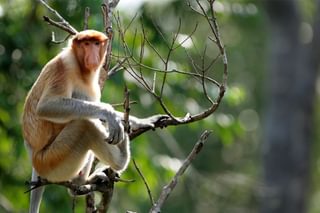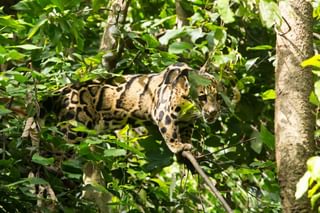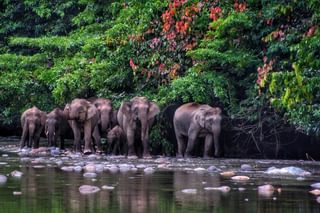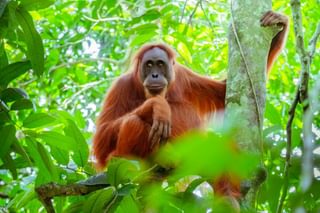Borneo Trip Inspiration
Speak to a Borneo expert today
and start planning your tailor-made holiday

Nia
Borneo Expert
Your guide to some of the incredible biodiversity that this island paradise has to offer

As the third largest island in the world, Borneo is a land shrouded in mystery and wonder. Located in the heart of the biodiverse “Coral Triangle” in Southeast Asia, this rugged emerald island harbours some of the most treasured old growth tropical rainforests left on Earth. Borneo’s incredibly diverse ecosystems support over 15,000 plant species and 222 mammal species, plus 420 species of bird and over 400 species of fish. Even more astounding, new species continue being discovered here yearly. Of its overall land area, almost 30% comprises protected areas with contrasting habitats ranging from alluvial plains to granite peaks over 13,000 ft high. Thanks to this array, Borneo contains a globally unparalleled density of flora and fauna.

Yet what truly sets Borneo’s wildlife apart is the high proportion of endemic species unique to the island. Isolated for millennia, evolutionary processes generated exotic forms found nowhere else like the eccentric proboscis monkey with its pendulous nose. Sadly over 50 mammals, birds and reptiles native to Borneo currently rank as endangered or critically endangered due to threats like deforestation. Preserving what remains before extinction silences these unique creatures remains paramount. Borneo’s wild soul still thrives within its protected forests making wildlife viewing exceptionally rewarding. Whether you seek to observe mischievous orangutans swinging through steamy jungle, a riot of multi-coloured birdwing butterflies gathered at a stream or the world’s largest flower blooming in the understory gloom, Borneo delivers magnificent biodiversity unknown elsewhere.

This blog provides an introduction highlighting iconic wildlife and prime viewing locations around Borneo. We’ll cover charismatic flagship species like orangutans, key endemic oddities like the proboscis monkey and strange plants like gigantic parasitic Rafflesia in addition to aerial acrobats, jungle cats, hornbills, mouse deer and more. If you’re intrigued by tropical nature and Asian wildlife, read on for insight into the incredible biodiversity persisting on the island of Borneo along with tips to maximize your chances of experiencing it first-hand. Let’s explore some of Earth’s rarest creatures only found on this wondrous emerald island.

One of the most iconic and instantly recognizable species found in Borneo is the majestic orangutan. Distinguished by their reddish-orange fur and human-like appearance and behaviours, orangutans spend most of their time swinging through the treetops of Borneo's steamy lowland rainforests. Their long arms and mobile hips allow them to build nests and traverse the canopy with ease in search of fruit. The best place to spot orangutans in the wild is the Kinabatangan Wildlife Sanctuary in Sabah. Take a river cruise down the Kinabatangan River and you may be rewarded with a sighting of these endearing great apes as they lounge in the branches or feed on fruit. Just don't forget your binoculars and camera!

Also partial to riverine rainforests is Borneo's most peculiar looking primate, the proboscis monkey. Identifiable by the male's large, drooping nose, proboscis monkeys live in family groups and can often be seen leaping from tree to tree or swimming across rivers in their habitat range, along coastal areas and river floodplains. One of the best locations to observe the amusing expressions and social dynamics of proboscis monkeys is the Lower Kinabatangan Wildlife Sanctuary where their distinctive honking calls echo through the forest. Stay at Kinabatangan Riverside Lodge to be truly surrounded by nature. A boat trip at dawn or dusk offers your best shot at viewing these unique animals in the wild.

Among the rarest and most endangered mammals found only on Borneo is the critically endangered Bornean rhinoceros, one of Asia’s three remaining rhino species. Also called the Sumatran rhino, these solitary rainforest dwellers stand just under 5 feet at the shoulder sporting signature thick folded skin reminiscent of armour plating. They prefer dense lowland forest and swamps where they browse on leafy shoots and fruit using their pointed upper lip.

Bornean rhinos are now believed functionally extinct in the wild with fewer than 80 individuals clinging to existence, making sightings nearly impossible. However, conservation efforts involving forest rangers monitor and protect their remaining habitat from threats like hunting and deforestation with hopes of encouraging the species’ recovery.

An exceptionally rare but intriguing rainforest denizen is the Sunda clouded leopard, a medium-sized wild cat identified by its distinctive “clouds” of darker dappled fur set against a lighter grey coat. A reddish stripe runs laterally along the leopard’s spine from shoulders to tail, the pattern unique to each individual. Seldom seen due to their reclusive nocturnal activity, clouded leopards occupy a range of forest habitats hunting small mammals, deer and wild boar. Deramakot Forest Reserve and Danum Valley Conservation Area represent prime areas to potentially glimpse one of these mystical cats as they blend into the shadows. Stay at the beautiful eco-retreat that is Borneo Rainforest Lodge to truly experience the rainforest.
Borneo holds a unique subspecies of the Asian elephant called the Borneo elephant. Inhabiting lowland rainforests, they sport larger ears, longer tails and straighter tusks than other Asian elephants. These gentle giants travel in herds foraging along jungle trails and riverbanks, ingesting a wide variety of greenery. Expanding palm oil plantations increasingly isolate their preferred habitat causing conflict with humans. However there is still hope to conserve populations with estimates of 2,000 remaining. Elephants can occasionally be spotted along the Kinabatangan River when they emerge to drink, bathe or graze providing a special encounter for fortunate observers.

Kinabalu park also provides a refuge for endangered Bornean sun bears. These small black bears get their name from the crescent marking across their chest rumored to resemble the rising or setting sun. They use their long tongues and claws to feed on fruits, termites and honey using their excellent climbing skills to traverse treetops despite their heavyset build. As Kinabalu’s largest land carnivore, sun bears play an important role in the park’s ecosystem but face threats from habitat loss. Visitors may luck out on sighting one of these elusive bears lumbering through the forest early in the morning when the park is quiet.

Borneo’s extensive limestone formations and mangrove forests provide ideal roosting sites for numerous bat species along the coast, including Southeast Asia’s largest, the flying fox. These old world fruit bats make their homes in tree canopies near the shore, forming gigantic colonies numbering over a million giant flying foxes at certain times of year. They sport fox-like faces, large eyes and impressive wingspans. At dusk, massive swarms of these mega-bats emerge from coastal mangrove roosts, setting off on aerial commutes inland to rainforest fruit orchards where they forage on ripe fruit and nectar. Observers stationed at the forest edge may witness these remarkable flying mammals in action as they leave coastal roosts to support regeneration of inland rainforest ecosystems through seed dispersal.

Borneo contains a highly specialised group of gliding mammals, that aren't quite bats, known as colugos or flying lemurs - although they are not true lemurs. These nocturnal tree-dwellers sport flaps of extra skin that extend between their limbs and torso allowing them to glide from tree to tree in search of the leaves, shoots, flowers and fruits they feast on. Attractive giant red flying squirrels also glide through Bornean rainforest canopies in eye-catching chestnut red and creamy white fur. Spot them leaving their tree hollow nests using parachute-like membranes called patagia to soar 100 meters to their next meal.


While animals may get top billing, Borneo also harbors some rather extraordinary plants like Rafflesia – the world's largest flower. This parasitic flowering plant lacks leaves and stems, living embedded within host plants. But its claim to fame lies in its colossal blooms which can reach up to 3 feet across! Rafflesia’s blooms burst forth, adopting an alien appearance of mottled rust red with white blotches and emanating a rather pungent rotting meat smell to attract carrion flies for pollination. Due to its parasitic nature, predicting where and when Rafflesia will bloom is a challenge. However forest reserves such as Gunung Gading National Park or Kota Kinabalu offer some of Borneo’s last remaining undisturbed forest habitat where your chances are best for witnessing this unique gigantic flower.
In addition to Rafflesia, Borneo's forests harbor numerous other unusual plants like carnivorous pitcher plants from the genus Nepenthes. Nepenthes grow modified pitcher-shaped leaves filled with digestive liquid designed to trap and digest insect prey, allowing these vines and shrubs to thrive in nutrient deficient soils. Borneo is a global hotspot for Nepenthes diversity - particularly sites like Kinabalu Park where massive 15 inch pitchers can be found amidst the mountain forests. For your best shot at seeing these evolutionary curiosities, hike Kinabalu’s Mesilau Trail kept moist by cool mountain runoff where traps glitter like jewels among the dense greenery.

In addition to mammals and plants, Borneo plays home to over 220 species of birds. One of the most distinguishable is the rhinoceros hornbill, named for the "casque" or solid ridge that sits above its large golden-yellow and red bill, reminiscent of a rhino's horn. These large black birds with white tails and bellies inhabit lowland and montane forests, using their massive bills to feed on fruit and small animals. Hornbills are adept fliers, crossing vast swaths of forest in search of fruit trees. Some of the best places to spot them are at canopy walkways like the 147 meter long walkway at Poring Hot Springs in Kinabalu Park, Sabah which offers eye-level views across the forest treetops.


Another stunning feathered resident is the Bornean green magpie, considered one of the most beautiful birds on the island. Metallic blue-green wings, an emerald body, bright yellow shoulders and a long graduated blue-green tail make this magpie truly spectacular. Found exclusively on Mt Kinabalu mountain at elevations above 1,400 meters, the elusive green magpie travels stealthily through sub-alpine brush and dense montane forest in small family groups, feeding on invertebrates and fruit. To catch a glimpse, take a guided birding tour along the nature trails of Kinabalu Park headquarters where these exotic creatures are occasionally sighted among the mountain vegetation.
While renowned for terrestrial and arboreal species, Borneo also harbors incredible aquatic life specially adapted to its complex river networks and coastal reef ecosystems. An endangered reptilian resident of fast-flowing rivers is the false gharial, a peculiar long-snouted crocodilian bearing a bulbous growth on the tip of its slender jaws. Unlike true gharials, this unique freshwater beast feeds on fish and small mammals rather than exclusively fish, using its adapted jaws to sweep side to side snapping up prey. Rivers also provide habitat for oddities like the smooth otter civet - an endangered mammal actually more closely related to weasels than otters.

Out to sea one discovers even greater wonders - Borneo lies in the heart of the "Coral Triangle" making its fringing reefs rank top biodiversity globally for coral, fish and marine invertebrates. Divers may glimpse schooling barracuda amidst coral guarded by the planet’s largest fish - whale sharks and manta rays that frequent these nutrient-rich waters. Whether in rivers or ocean, Borneo’s aquatic ecosystems pulse with unique endemic life forms. Enjoy time at Gaya Island Resort to truly make the most of the incredible marine wildlife that Borneo has to offer.

With its incredibly biodiverse rainforests, towering mountains and complex ecosystems, Borneo offers unparalleled opportunities to observe some truly magnificent and endangered wildlife in their natural habitats. From charismatic species like the orangutans, proboscis monkeys, rhinoceros hornbills and sun bears to strange plants like Rafflesia and Nepenthes pitcher plants to aerial acrobats like flying lemurs and squirrels, Borneo delivers remarkable diversity.

And we’ve still only highlighted a fraction of the thousands of unique species on the island. Whether you’re a hardcore wildlife lover, casual nature enthusiast or simply adventurous, a visit to Borneo's protected forests and reserves promises encounters with exotic creatures found nowhere else on Earth, making for an exciting and memorable experience.
and start planning your tailor-made holiday

Borneo Expert